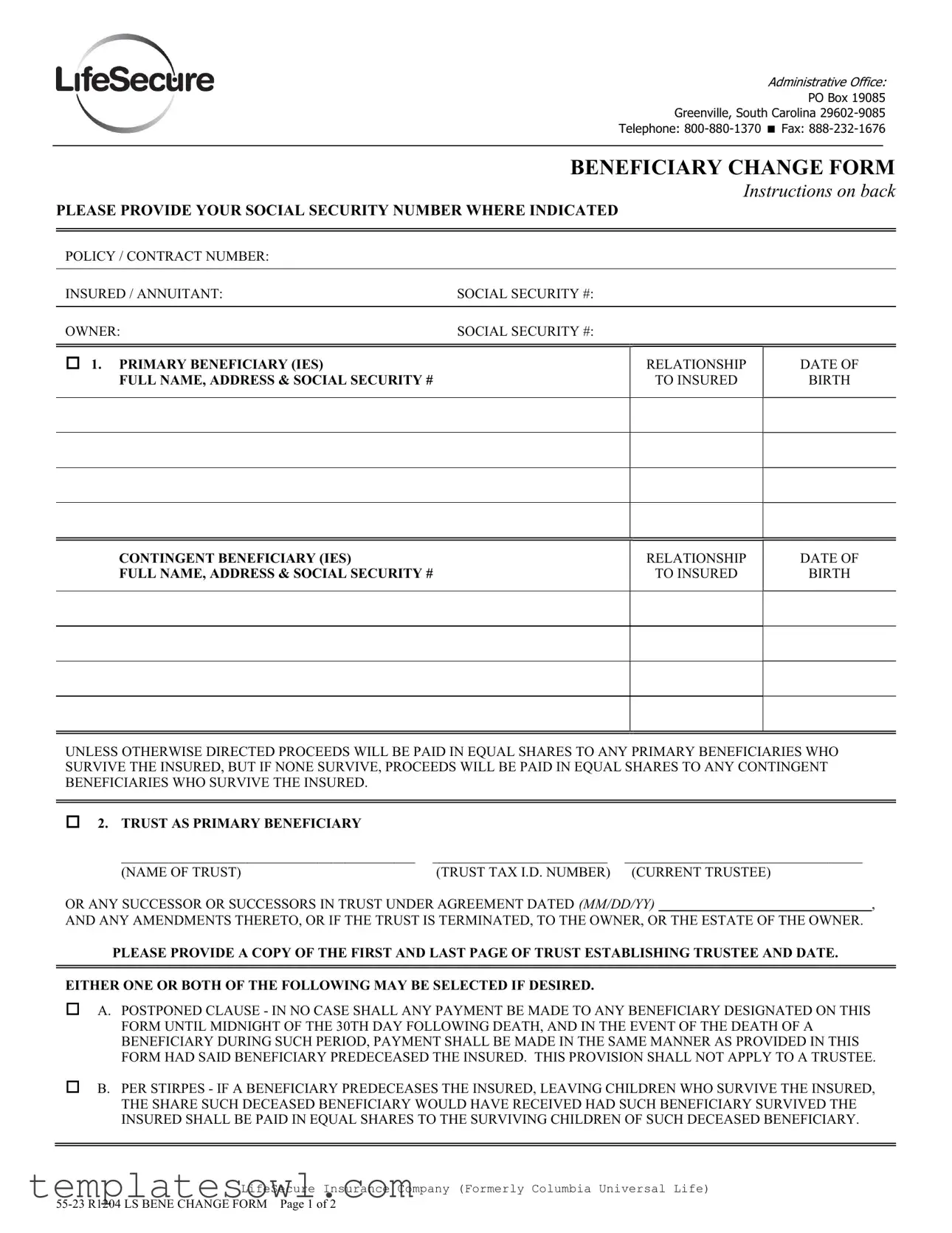Administrative Office:
PO Box 19085
Greenville, South Carolina 29602-9085
Telephone: 800-880-1370 Fax: 888-232-1676
BENEFICIARY CHANGE FORM
Instructions on back
PLEASE PROVIDE YOUR SOCIAL SECURITY NUMBER WHERE INDICATED
POLICY / CONTRACT NUMBER:
INSURED / ANNUITANT: |
SOCIAL SECURITY #: |
|
|
|
|
|
OWNER: |
SOCIAL SECURITY #: |
|
1. PRIMARY BENEFICIARY (IES) |
|
|
|
|
RELATIONSHIP |
DATE OF |
FULL NAME, ADDRESS & SOCIAL SECURITY # |
|
TO INSURED |
BIRTH |
|
|
|
|
|
|
|
|
|
|
|
|
|
|
|
|
|
|
|
|
|
|
|
|
CONTINGENT BENEFICIARY (IES) |
RELATIONSHIP |
DATE OF |
FULL NAME, ADDRESS & SOCIAL SECURITY # |
TO INSURED |
BIRTH |
|
|
|
|
|
|
|
|
|
|
|
|
|
|
|
UNLESS OTHERWISE DIRECTED PROCEEDS WILL BE PAID IN EQUAL SHARES TO ANY PRIMARY BENEFICIARIES WHO SURVIVE THE INSURED, BUT IF NONE SURVIVE, PROCEEDS WILL BE PAID IN EQUAL SHARES TO ANY CONTINGENT BENEFICIARIES WHO SURVIVE THE INSURED.
2. TRUST AS PRIMARY BENEFICIARY |
|
|
|
__________________________________________ |
_________________________ |
__________________________________ |
|
(NAME OF TRUST) |
(TRUST TAX I.D. NUMBER) |
(CURRENT TRUSTEE) |
|
OR ANY SUCCESSOR OR SUCCESSORS IN TRUST UNDER AGREEMENT DATED (MM/DD/YY) |
, |
AND ANY AMENDMENTS THERETO, OR IF THE TRUST IS TERMINATED, TO THE OWNER, OR THE ESTATE OF THE OWNER.
PLEASE PROVIDE A COPY OF THE FIRST AND LAST PAGE OF TRUST ESTABLISHING TRUSTEE AND DATE.
EITHER ONE OR BOTH OF THE FOLLOWING MAY BE SELECTED IF DESIRED.
A. POSTPONED CLAUSE - IN NO CASE SHALL ANY PAYMENT BE MADE TO ANY BENEFICIARY DESIGNATED ON THIS
FORM UNTIL MIDNIGHT OF THE 30TH DAY FOLLOWING DEATH, AND IN THE EVENT OF THE DEATH OF A BENEFICIARY DURING SUCH PERIOD, PAYMENT SHALL BE MADE IN THE SAME MANNER AS PROVIDED IN THIS FORM HAD SAID BENEFICIARY PREDECEASED THE INSURED. THIS PROVISION SHALL NOT APPLY TO A TRUSTEE.
B. PER STIRPES - IF A BENEFICIARY PREDECEASES THE INSURED, LEAVING CHILDREN WHO SURVIVE THE INSURED, THE SHARE SUCH DECEASED BENEFICIARY WOULD HAVE RECEIVED HAD SUCH BENEFICIARY SURVIVED THE INSURED SHALL BE PAID IN EQUAL SHARES TO THE SURVIVING CHILDREN OF SUCH DECEASED BENEFICIARY.
LifeSecure Insurance Company (Formerly Columbia Universal Life)
55-23 R1204 LS BENE CHANGE FORM Page 1 of 2

I DIRECT THAT ANY ENDORSEMENT OF THE POLICY REQUESTED BE EFFECTED BY RETURN OF THIS REQUEST WITH THE COMPANY'S ACKNOWLEDGMENT. I AGREE THAT THE COMPANY MAY WAIVE ANY POLICY PROVISION REQUIRING PRESENTATION ON THE POLICY FOR ENDORSEMENT, BUY MAY REQUIRE SUCH PRESENTATION IF DESIRED.
DATED AT |
THIS |
DAY OF |
, 20_____ |
|
|
_______________________________________________ |
WITNESS (PLEASE SEE BELOW*) |
|
SIGNATURE OF POLICY/CONTRACT OWNER |
|
|
(IF OWNED BY A COMPANY, NEED TWO SIGNATURES |
|
|
AND INCLUDE TITLE |
|
THE UNDERSIGNED AGREES TO THE ABOVE REQUESTS AND CHANGES |
|
|
|
SIGNATURE OF IRREVOCABLE BENEFICIARY (IF ANY) |
SIGNATURE OF ASSIGNEE, INCLUDE TITLE (IF ANY) |
|
FOR ADMINISTRATIVE OFFICE USE ONLY
ACKNOWLEDGMENT OF REQUEST FOR CHANGE - PLEASE ATTACH TO POLICY
THE ABOVE COMPANY HAS RECORDED THE CHANGE REQUESTED
DATED AT GREENVILLE, SOUTH CAROLINA |
|
BY |
|
|
|
*BE SURE TO HAVE THE POLICYOWNER'S SIGNATURE WITNESSED BY SOMEONE WHO IS NOT A RELATIVE OR BENEFICIARY
INSTRUCTIONS FOR CHANGING BENEFICIARY
THE FULL LEGAL NAME AND RELATIONSHIP TO THE INSURED OF EACH PRIMARY AND CONTINGENT BENEFICIARY IS TO BE CLEARLY SHOWN. FOR EXAMPLE, MARTHA BROWN SMITH (WIFE) AND NOT MRS. JOHN H. SMITH (WIFE).
IF THE POLICY IS ASSIGNED, THE ASSIGNEE MUST JOIN IN SIGNING THE CHANGE OF BENEFICIARY AGREEMENT. THE CHANGE OF BENEFICIARY AGREEMENT MUST BE DATED, AND YOUR SIGNATURE AND THAT OF THE ASSIGNEE MUST BE WITNESSED BY A RESPONSIBLE ADULT.
ALL SIGNATURES ARE TO BE IN INK. THE CHANGE WILL BE RECORDED BY US AND A COPY WILL BE RETURNED TO THE OWNER. PLEASE DO NOT SEND US YOUR POLICY.
THE POLICYOWNER REVOKES ANY PREVIOUS DESIGNATION OF BENEFICIARY AND METHOD OF SETTLEMENT FOR THE POLICY. RECORDING THE INSTRUMENT THE COMPANY AGREES, THAT THE CHANGE OF BENEFICIARY REQUESTED SHALL BECOME EFFECTIVE UPON RECEIPT AND RECORDING OF THIS PROPERLY COMPLETED FORM BY THE COMPANY, DURING THE LIFETIME OF THE INSURED, AT ITS HOME OFFICE IN AUSTIN, TEXAS; AND SUBJECT TO THE PROVISIONS OF THE POLICY.
WHEN MORE THAN ONE PRIMARY BENEFICIARY IS NAMED, PAYMENT SHALL BE MADE SHARE AND SHARE ALIKE, SURVIVORS AND SURVIVOR. THIS SIMILARLY APPLIES WHEN MULTIPLE CONTINGENT BENEFICIARIES ARE NAMED AND BECOME ENTITLED TO THE PROCEEDS OF THIS POLICY.
IF A CHANGE OF BENEFICIARY IS DESIRED ON MORE THAN ONE POLICY, COMPLETE A SEPARATE FORM FOR EACH POLICY. FOR EACH INSURED COVERED UNDER ONE POLICY, COMPLETE A SEPARATE FORM.
PLACE AN "X" IN ONLY ONE OF THE BOXES NUMBERED 1 OR 2 AND INDICATE THE DESIRED BENEFICIARY IN THE SPACE PROVIDED. IF MORE THAN ONE BOX IS MARKED, THE FORM WILL BE RETURNED FOR CLARIFICATION AND PROCESSING WILL BE DELAYED. GIVE THE FULL NAME (FIRST NAME, MIDDLE INITIAL, AND LAST NAME) AND ADDRESS OF THE DESIRED BENEFICIARY (IES) AND THE RELATIONSHIP, IF ANY, OF EACH TO THE INSURED AND THE DATE OF BIRTH. FOR DESIGNATION NUMBER 2, PROVIDE THE TRUST NAME AND GIVE THE DATE OF THE TRUST AGREEMENT.
IMPORTANT:
PLEASE PROVIDE THE NAME, ADDRESS, SOCIAL SECURITY NUMBER AND THE RELATIONSHIP TO THE INSURED FOR EACH BENEFICIARY, OR IF THE CLASS OF BENEFICIARIES IS NAMED, THE NAME OF EACH CURRENT BENEFICIARY IN THE CLASS.
55-23 0901 LS BENE CHANGE FORM |
Page 2 of 2 |


